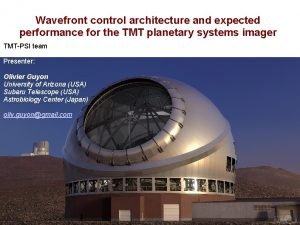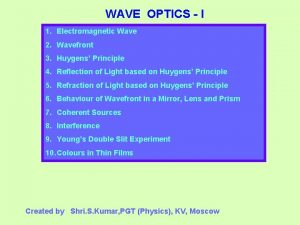A noiseless 512 x 512 wavefront detector for

- Slides: 1

A noiseless 512 x 512 wave-front detector for adaptive optics with k. Hz frame rates University of Geneva (Allan G. Clark, Bettina Mikulec) - SSL Berkeley - Medipix Collaboration Motivation Detector Concept • Adaptive Optics are indispensable for new generation ground-based telescopes! 1. A photon releases a photo-electron from the high-QE photocathode (Ga. As). • Detectors for wave-front sensors (WFS) require large pixel arrays (512 x 512), noise <3 e- per pixel, high quantum efficiency (QE) and k. Hz frame rates* 2. The electron enters one of the tiny pores of a microchannel-plate (MCP) detector where it gets amplified (gain variable between several thousands to millions). • Current CCD have high QE, but must trade noise performance and array size for speed 3. The exiting charge cloud gets detected by the Medipix 2 pixel circuits. If detected charge > threshold --> pixel counter gets incremented. 4. Noiseless chip readout after programmable shutter time. Point-like objects get blurred by turbulences in the atmosphere. WFS measure the atmospheric turbulences, send this information to deformable mirrors that compensate online for the distortions. Shack-Hartman correction method using an equally spaced lenslet array. AO reveals a previously undetected star in the Orion cluster. The surface plot shows the dramatic increase in intensity and sharpness. * Angel, R. et al. ‘A Roadmap for the Development of Astronomical Adaptive Optics’, July 6, 2000; http: //www. noao. edu/dir/ao/ Medipix 2* Photon Counting Pixel Readout ASIC • 256 x 256 pixels, 55 m square Measurement Results • Detector concept works! • Flood fields show MCP fixed pattern noise that divides out take 2 independent uniform illuminations (flood fields) • window discriminator, 14 -bit counter pixel • 3 -side buttable (512 x 512 arrays), serial (LVDS) or parallel readout (32 -bit CMOS bus; 266 s @ 100 MHz) histogram • ~500 transistors/pixel; 0. 25 m CMOS technology • Developed within the framework of the Medipix Collaboration; http: //medipix. web. cern. ch/MEDIPIX/ Flood field (500 Mcps). Ratio = flood 1 / flood 2. Histogram of ratio is consistent with counting statistics. • Spatial resolution consistent with theory (Nyqvist sampling of 55 m pixels) increase shutter time Test pattern; 100 s exposure. The spots correspond to individual photon events. Test pattern; 1 s exposure. Group 3 -2 visible ~9 lp/mm. • Parameters can be tuned to optimize spot size Spot area versus rear field. Spot area versus Medipix 2 low threshold.

